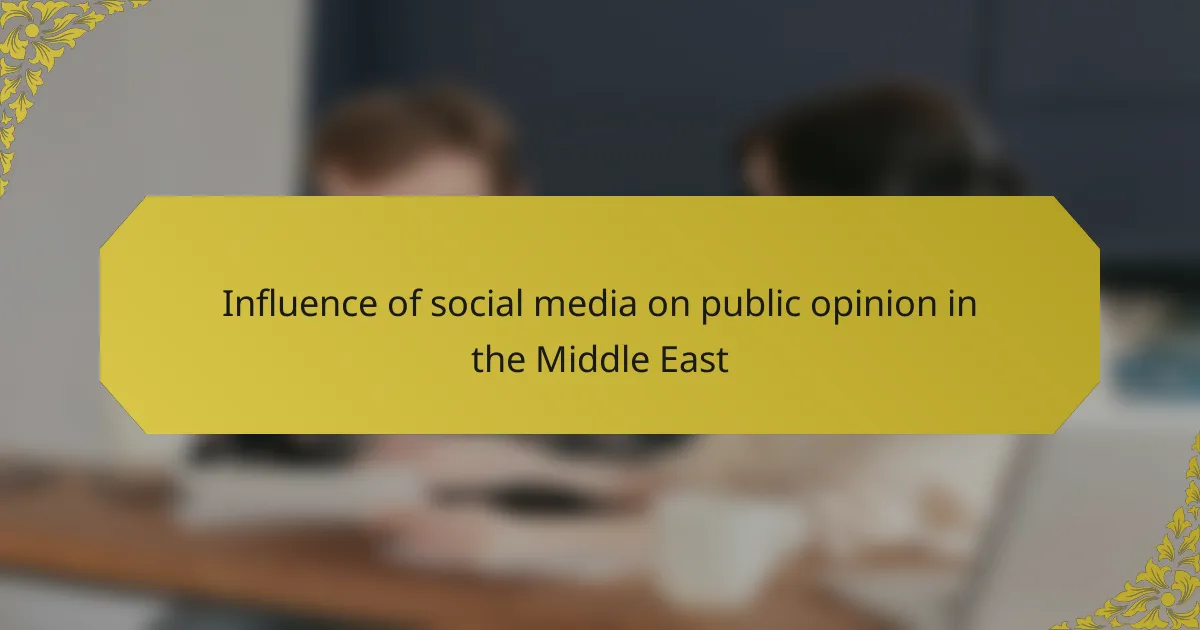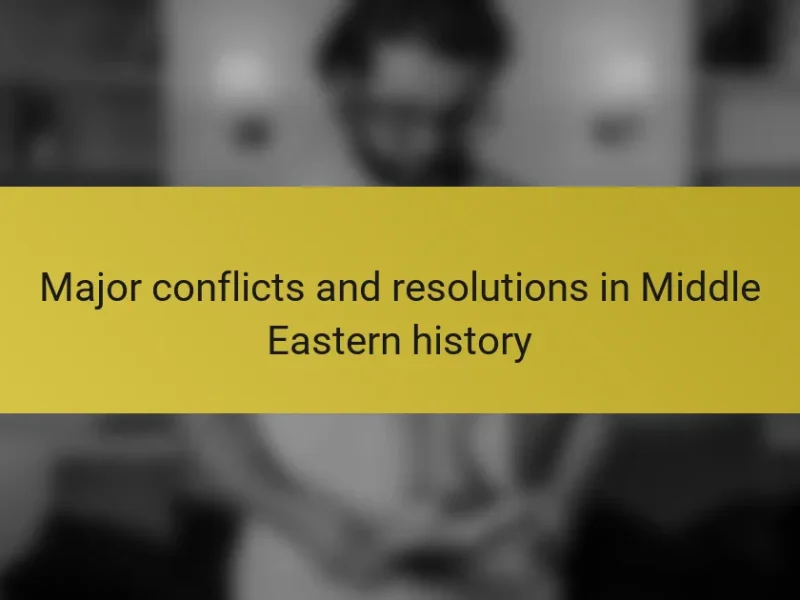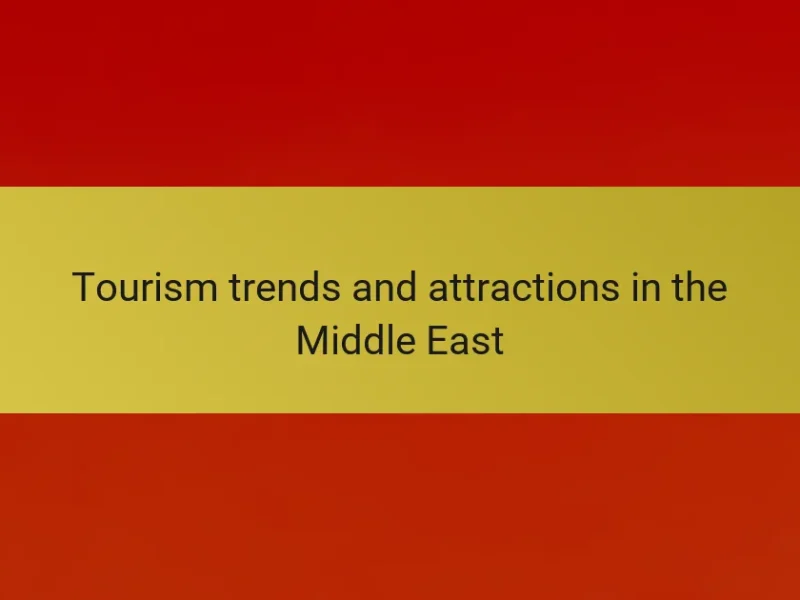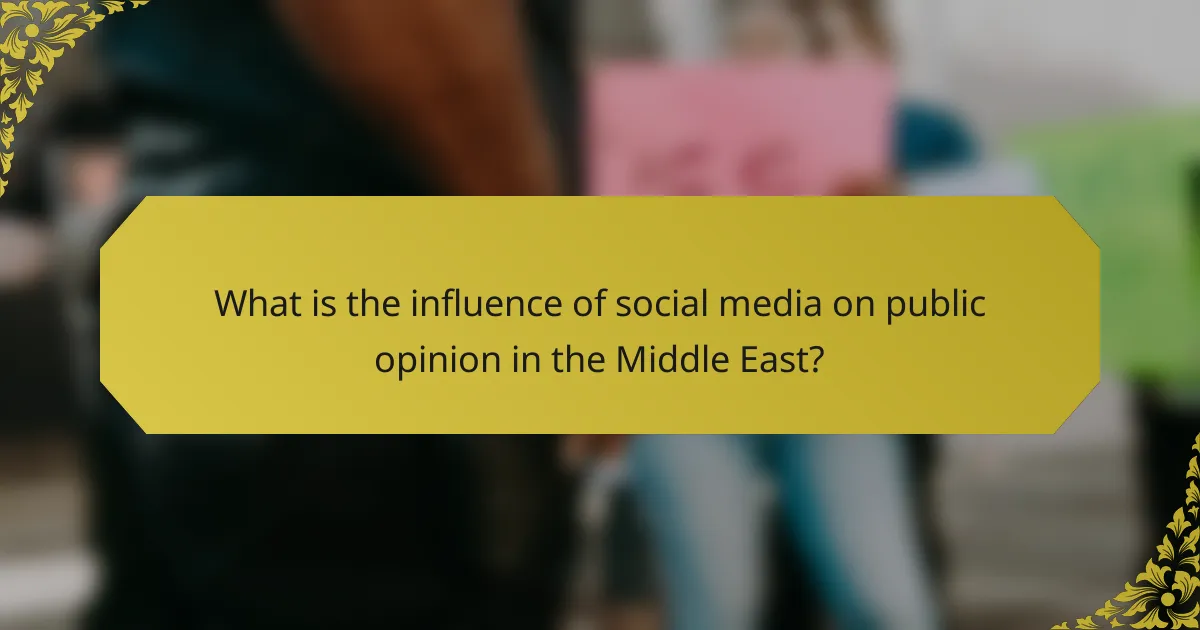
What is the influence of social media on public opinion in the Middle East?
Social media significantly influences public opinion in the Middle East. It provides a platform for citizens to express their views and engage in discussions. Social media enables rapid dissemination of information, shaping perceptions and attitudes. During events like the Arab Spring, platforms like Twitter and Facebook mobilized protests and spread awareness. Studies show that 70% of young people in the region use social media to access news. This trend shifts traditional media’s role in shaping public discourse. Social media can amplify dissent and challenge governmental narratives. It also facilitates the organization of grassroots movements, changing political landscapes.
How has social media changed public discourse in the region?
Social media has significantly transformed public discourse in the Middle East. It has facilitated rapid information sharing and mobilization of public opinion. Platforms like Twitter and Facebook have enabled voices that were previously marginalized to be heard. This shift has allowed for greater engagement in political discussions and social movements. For instance, during the Arab Spring, social media played a crucial role in organizing protests and disseminating information. Studies indicate that social media has increased political awareness among citizens. As a result, traditional media’s influence has diminished. Overall, social media has democratized communication and empowered individuals in the region.
What platforms are most influential in shaping public opinion?
Social media platforms such as Facebook, Twitter, and Instagram are most influential in shaping public opinion. These platforms facilitate rapid information dissemination and engagement among users. Facebook has over 2.8 billion monthly active users, making it a key player in public discourse. Twitter enables real-time conversations and trending topics, impacting perceptions swiftly. Instagram, with its visual content, influences public sentiment, especially among younger demographics. Research indicates that social media can sway political views and mobilize social movements. A study by the Pew Research Center found that 64% of Americans use social media to engage with news. This highlights the significant role these platforms play in shaping opinions.
How do cultural factors affect social media’s role in public opinion?
Cultural factors significantly shape social media’s role in public opinion. They influence the content shared and the engagement levels of users. In the Middle East, cultural norms dictate acceptable topics for discussion. This can lead to a focus on community and family values. Social media platforms often amplify these cultural narratives. For instance, local traditions may be highlighted in posts and discussions. Additionally, cultural sensitivity affects how messages are received. Users may respond differently based on their cultural background. Research shows that cultural context can impact social media interactions and public sentiment. Understanding these factors is crucial for effective communication in the region.
Why is understanding this influence important?
Understanding the influence of social media on public opinion in the Middle East is crucial for several reasons. Social media shapes perceptions and behaviors of millions of users in the region. It serves as a primary source of information and a platform for discourse. This influence can alter political landscapes and social norms. For instance, during the Arab Spring, social media facilitated mobilization and awareness. Studies show that 60% of Middle Easterners rely on social media for news. Understanding this influence helps policymakers and organizations engage effectively with the public. It also aids in addressing misinformation and fostering constructive dialogue.
What implications does social media have for political movements?
Social media significantly influences political movements by facilitating communication and mobilization. It allows users to organize protests and share information rapidly. For instance, during the Arab Spring, platforms like Twitter and Facebook played crucial roles in mobilizing crowds. Research by the Pew Research Center indicates that 88% of social media users in the Middle East believe these platforms are vital for political engagement. Additionally, social media enables the dissemination of alternative narratives that challenge state-controlled media. This shift can empower marginalized voices and foster greater political participation. Overall, social media acts as a catalyst for change in political landscapes.
How does social media impact civic engagement and activism?
Social media significantly enhances civic engagement and activism. It provides platforms for individuals to organize, mobilize, and share information quickly. For instance, social media campaigns have been instrumental in movements like the Arab Spring. According to a study by the Pew Research Center, 88% of social media users in the Middle East reported that these platforms helped them engage in political discussions. Furthermore, social media facilitates the dissemination of information, allowing users to spread awareness about social issues rapidly. This immediacy can lead to increased participation in protests and civic actions. Overall, social media serves as a catalyst for civic engagement and activism by amplifying voices and fostering community action.
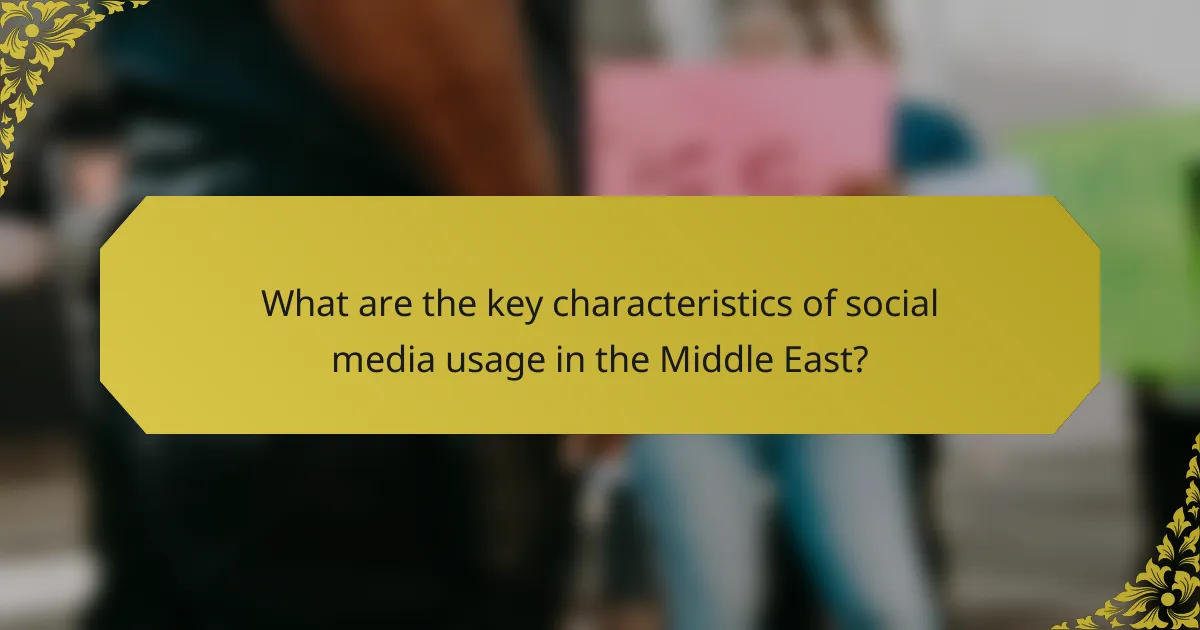
What are the key characteristics of social media usage in the Middle East?
Social media usage in the Middle East is characterized by high [censured] rates and diverse platforms. According to a 2022 report by We Are Social, over 70% of the population engages with social media. Popular platforms include Facebook, Instagram, and Twitter, with usage varying by country. The region sees significant engagement for news consumption and political discourse. Youth demographics dominate social media users, with a large portion under 30. Arabic content is increasingly prevalent, reflecting local cultures and issues. Social media serves as a critical tool for activism and mobilization during protests. Additionally, government regulations impact the freedom of expression on these platforms.
What demographic trends are evident in social media usage?
Younger demographics dominate social media usage. According to a Pew Research Center study, 90% of adults aged 18-29 use social media. In contrast, only 40% of adults aged 65 and older engage with these platforms. Gender also plays a role; women are more likely to use platforms like Instagram and Pinterest, while men lean towards platforms like Reddit and LinkedIn. Additionally, urban populations show higher social media engagement compared to rural areas. This trend is evident in the Middle East, where youth populations are increasingly active on platforms like Twitter and Facebook. As of 2023, the Arab Youth Survey indicates that 70% of young Arabs use social media to express their opinions. These trends highlight the significant role of age, gender, and location in social media usage patterns.
How do age and gender influence social media engagement?
Age and gender significantly influence social media engagement. Younger users, particularly those aged 18-24, tend to engage more actively on platforms like Instagram and TikTok. In contrast, older demographics, such as those over 50, often prefer Facebook for social interaction. Gender differences also play a role; studies show that women generally engage more with social media content than men. For instance, women are more likely to share posts and participate in discussions. Additionally, men often consume content more passively. Research conducted by Pew Research Center highlights these trends, showing that 69% of adults aged 18-29 use Instagram compared to only 13% of those aged 65 and older. This demonstrates that both age and gender are critical factors in shaping social media engagement patterns.
What role does education play in social media adoption?
Education significantly influences social media adoption. Higher levels of education correlate with increased social media usage. Educated individuals are more likely to access and engage with various platforms. They possess better digital literacy skills, enabling them to navigate social media effectively. Research indicates that educated populations are more open to adopting new technologies. For instance, a study by Pew Research Center found that 75% of college graduates use social media compared to 45% of those without a high school diploma. This trend highlights the role of education in fostering familiarity and comfort with social media platforms.
What types of content are most shared and discussed?
Visual content, such as images and videos, is most shared and discussed on social media. This type of content captures attention quickly and engages users effectively. According to a study by HubSpot, posts with images receive 94% more views than those without. Additionally, videos are shared 1,200% more than text and links combined, as reported by Wordstream. Informative articles and infographics also generate significant discussion, as they provide valuable insights and data. Interactive content, like polls and quizzes, encourages user participation and sharing. Overall, engaging, informative, and visually appealing content drives social media discussions and shares.
How does the nature of content affect public opinion formation?
The nature of content significantly affects public opinion formation. Content that is emotionally charged tends to engage audiences more effectively. Research indicates that emotionally resonant content is shared more widely on social media platforms. This sharing amplifies its reach and influence on public perceptions. Furthermore, factual and informative content can shape opinions by providing context and clarity. Studies show that misinformation can distort public understanding, leading to polarized views. In the Middle East, social media content often reflects cultural and political narratives, which can sway public sentiment. Thus, the type and quality of content play crucial roles in shaping public opinion.
What role do memes and viral content play in shaping narratives?
Memes and viral content significantly shape narratives in social media. They serve as tools for rapid information dissemination. Memes can simplify complex issues into relatable visuals. This makes them easily shareable and memorable. Viral content often reflects cultural sentiments and social issues. It can influence public opinion by framing discussions. In the Middle East, memes have been used in political movements. They can mobilize support or dissent quickly. Research shows that memes can alter perceptions and behaviors. This highlights their power in narrative construction.
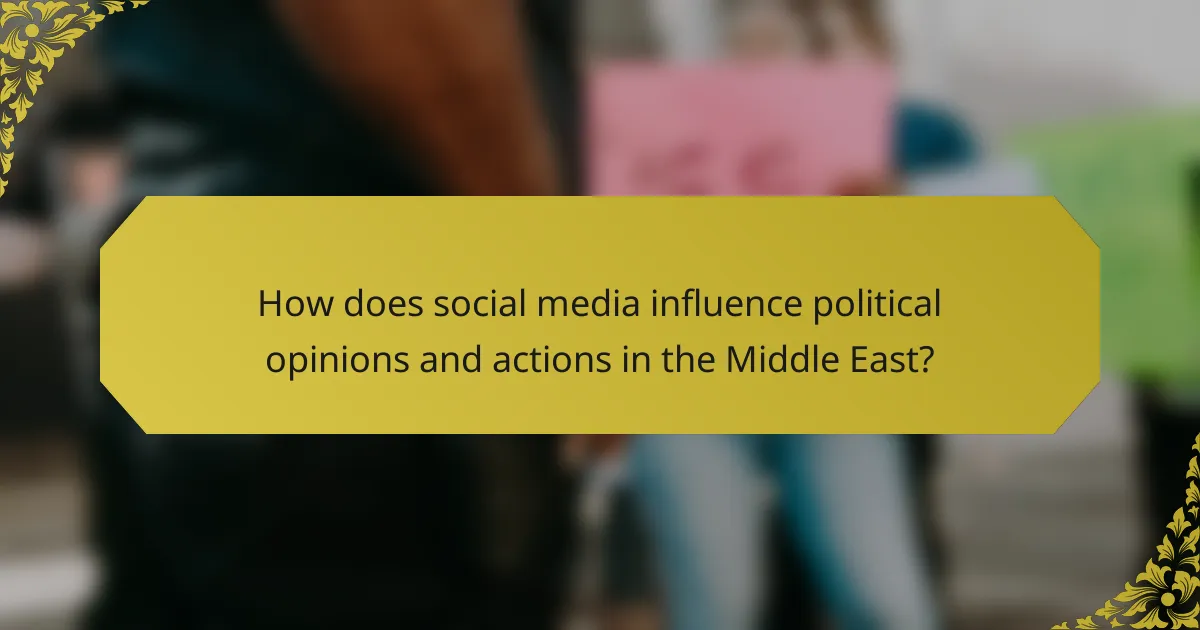
How does social media influence political opinions and actions in the Middle East?
Social media significantly influences political opinions and actions in the Middle East. Platforms like Twitter and Facebook facilitate the rapid dissemination of information. This allows users to share news, opinions, and mobilize support for political causes. During events like the Arab Spring, social media played a crucial role in organizing protests. Studies show that social media can shape public perception by highlighting specific issues. For instance, the 2011 protests in Egypt were largely organized through these platforms. Research indicates that youth engagement on social media correlates with increased political activism. The ability to bypass traditional media channels empowers citizens to voice dissent. Overall, social media serves as a catalyst for political change in the region.
What role does social media play in political mobilization?
Social media plays a crucial role in political mobilization by facilitating communication and organization among individuals. It allows users to share information quickly and widely, which can inspire collective action. For instance, during the Arab Spring, platforms like Facebook and Twitter were pivotal in organizing protests and disseminating information. Research shows that social media can increase political engagement, especially among younger demographics. A study by the Pew Research Center found that 66% of social media users in the Middle East reported using these platforms for political discussions. This demonstrates how social media can serve as a powerful tool for mobilizing citizens and shaping political landscapes.
How have recent protests been organized through social media?
Recent protests have been organized through social media by utilizing platforms for communication and mobilization. Activists create event pages to gather participants and share information. Social media allows for real-time updates and coordination among protesters. Hashtags help unify messages and increase visibility. Platforms like Twitter and Facebook facilitate the rapid spread of information. This digital organization has proven effective in countries like Sudan and Iran. Studies show that social media significantly influences public opinion and engagement during protests.
What strategies do political entities use on social media?
Political entities use various strategies on social media to influence public opinion. They create targeted advertisements to reach specific demographics. These ads often highlight key issues or policies that resonate with voters. Political entities also engage in direct communication with followers. This includes responding to comments and sharing user-generated content. They utilize hashtags to increase visibility and participation in discussions. Additionally, they analyze engagement metrics to adapt their strategies. This data-driven approach helps refine messaging and outreach efforts. Studies show that these strategies can significantly shape public perception and voter behavior in the Middle East.
How does misinformation affect public opinion on social media?
Misinformation significantly alters public opinion on social media. It spreads rapidly, influencing perceptions and beliefs. A study by the Pew Research Center found that 64% of Americans believe misinformation causes confusion about basic facts. This confusion can lead to polarization among different groups. Misinformation often targets sensitive topics, such as politics and health. For instance, false claims about COVID-19 vaccines led to increased vaccine hesitancy. Social media algorithms often amplify sensational content, increasing its visibility. This amplification can create echo chambers, reinforcing existing biases. Ultimately, misinformation undermines trust in credible sources and institutions.
What are the sources and types of misinformation prevalent in the region?
Misinformation in the Middle East primarily originates from social media platforms, state-controlled media, and unofficial news sources. Social media facilitates rapid spread of false narratives and conspiracy theories. State-controlled media often disseminates biased information to support government agendas. Unofficial news sources can amplify rumors without verification. Common types of misinformation include political propaganda, health-related falsehoods, and misinformation about conflicts. For instance, during regional conflicts, social media often showcases manipulated images and misleading reports. Additionally, health misinformation can spread quickly, especially during crises like the COVID-19 pandemic. This landscape creates challenges for public understanding and trust in credible information sources.
How can users identify and combat misinformation?
Users can identify and combat misinformation by verifying sources and cross-checking information. They should assess the credibility of the information by checking the author’s qualifications and the publication’s reputation. Fact-checking websites like Snopes or FactCheck.org can help confirm claims. Users can also look for citations and references in articles to evaluate their reliability. Engaging with multiple perspectives can provide a more comprehensive understanding of an issue. Additionally, users should be cautious of sensational headlines and emotionally charged content, as these often indicate misinformation. Studies show that critical thinking skills improve the ability to discern credible information from falsehoods.
What are best practices for using social media to influence public opinion positively?
Best practices for using social media to influence public opinion positively include creating authentic content that resonates with the audience. Engaging storytelling can capture attention and foster emotional connections. Consistent messaging across platforms reinforces key ideas and builds trust. Utilizing visuals enhances engagement; posts with images receive 94% more views. Encouraging user-generated content fosters community involvement and gives a voice to followers. Monitoring and responding to feedback shows responsiveness and builds rapport. Collaborating with credible influencers can amplify messages and reach broader audiences. Lastly, analyzing data helps refine strategies for maximum impact and effectiveness.
How can individuals and organizations effectively engage on social media?
Individuals and organizations can effectively engage on social media by creating relevant and engaging content. This content should resonate with the target audience’s interests and needs. Posting consistently helps maintain visibility and encourages interaction. Utilizing multimedia, such as images and videos, can increase engagement rates, as studies show that posts with visuals receive 94% more views. Responding promptly to comments and messages fosters a sense of community and trust. Monitoring analytics is essential for understanding what content performs best and refining strategies accordingly. Collaborating with influencers can expand reach and credibility. Engaging in trending topics and using relevant hashtags can also enhance visibility and participation.
What strategies can be employed to promote constructive dialogue online?
Promoting constructive dialogue online involves several effective strategies. First, establishing clear guidelines for communication encourages respectful interactions. Research shows that platforms with defined community standards see less hostility. Second, moderating discussions actively helps maintain a positive environment. Studies indicate that active moderation can reduce toxic behavior significantly. Third, encouraging diverse perspectives fosters richer conversations. Engaging users from various backgrounds enhances understanding and empathy. Fourth, utilizing prompts or questions can guide discussions productively. This method has been shown to increase engagement and relevance in conversations. Finally, providing resources for conflict resolution equips users with tools to handle disagreements constructively. These strategies collectively contribute to a healthier online discourse, particularly in sensitive contexts like the Middle East.
The main entity of this article is the influence of social media on public opinion in the Middle East. The article examines how social media platforms like Facebook and Twitter have transformed public discourse, enabling rapid information dissemination and mobilization of political movements, particularly during events like the Arab Spring. It highlights key characteristics of social media usage in the region, demographic trends, and the impact of cultural factors on engagement. Additionally, the article addresses the role of misinformation, strategies for positive engagement, and best practices for fostering constructive dialogue online. Overall, it provides a comprehensive overview of social media’s significant impact on shaping political opinions and civic activism in the Middle East.
